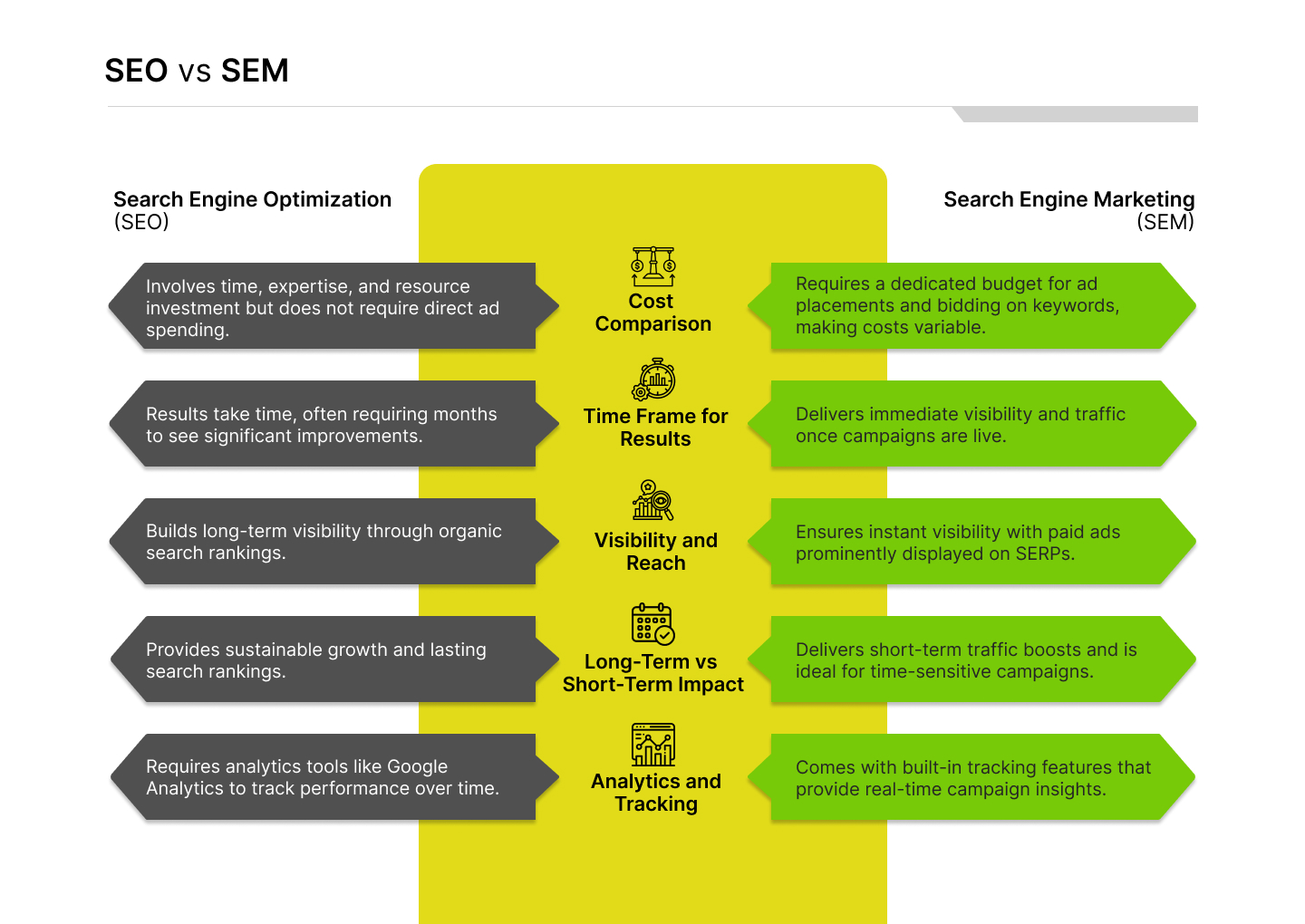What is SEO?
Definition of SEO
Search Engine Optimization (SEO) involves optimizing a website to rank higher on search engine results pages (SERPs) organically, driving unpaid traffic. It focuses on improving various aspects of a website, including content, structure and user experience.
How SEO Works
On-Page SEO
This involves optimizing individual web pages by using relevant keywords, creating high-quality content, enhancing meta tags and ensuring a smooth user experience. On-page SEO focuses on factors within your website's control.
Off-Page SEO
Off-page SEO includes activities like link building, guest blogging, influencer outreach and social media promotion. These strategies boost a website's authority and credibility through external endorsements.
Technical SEO
Technical SEO focuses on the website's backend structure. It ensures the site is fast, mobile-friendly, properly indexed and secure with HTTPS. Good technical SEO makes the site easier for search engines to crawl and rank.
Benefits of SEO
-
Increased Organic Traffic: Optimizing your site can improve its visibility, attracting more visitors without paid advertising.
-
Improved Brand Credibility: Ranking high in search results builds trust and credibility among users.
-
Cost-Effective Marketing: SEO reduces dependency on paid ads by generating consistent organic traffic.
-
Long-Term Visibility: Unlike paid campaigns, SEO-driven visibility can last for years with ongoing optimization.
Types of SEO Strategies
-
White-Hat SEO: Optimizing your site can improve its visibility, attracting more visitors without paid advertising.
-
Black-Hat SEO: Ranking high in search results builds trust and credibility among users.
-
Gray-Hat SEO:SEO reduces dependency on paid ads by generating consistent organic traffic.
What is SEM?
Definition of SEM
Search Engine Marketing (SEM) involves paid advertising strategies aimed at increasing visibility on search engine results pages (SERPs). It allows businesses to bid on specific keywords and appear in prominent positions in search results.
How SEM Works
Search Engine Advertising
Businesses pay search engines like Google to display their ads at the top of search results. This is done through platforms like Google Ads, ensuring that their content reaches potential customers quickly.
Paid Search Campaigns
These include pay-per-click (PPC) campaigns, where advertisers bid on keywords. When users click on the ad, the business pays a fee, driving traffic directly to its website.
-
Immediate Visibility: Paid ads appear at the top of search results as soon as campaigns are activated.
-
Targeted Reach: Ads can be tailored to specific demographics, locations and interests for higher relevance.
-
Measurable ROI: Campaign performance can be tracked through detailed metrics like click-through rates, impressions and conversions.
-
Budget Flexibility: Businesses can control costs by adjusting budgets, bids and targeting parameters.
-
Google Ads: The largest and most popular search advertising platform, offering extensive targeting options.
-
Bing Ads: A viable alternative with lower competition and competitive bidding costs.
-
Yahoo Search Ads: Another platform offering paid search advertising, especially for niche audiences.
Key differences between SEO and SEM

-
SEO: Involves time, expertise and resource investment but does not require direct ad spending.
-
SEM: Requires a dedicated budget for ad placements and bidding on keywords, making costs variable.
-
SEO: Results take time, often requiring months to see significant improvements.
-
SEM: Delivers immediate visibility and traffic once campaigns are live.
-
SEO: Builds long-term visibility through organic search rankings.
-
SEM: Ensures instant visibility with paid ads prominently displayed on SERPs.
-
SEO: Provides sustainable growth and lasting search rankings.
-
SEM: Delivers short-term traffic boosts and is ideal for time-sensitive campaigns.
-
SEO: Requires analytics tools like Google Analytics to track performance over time.
-
SEM: Comes with built-in tracking features that provide real-time campaign insights.
How SEO and SEM Work Together
Integrated Marketing Approach
Combining SEO and SEM ensures both immediate and long-term digital marketing success. While SEM drives instant traffic, SEO builds a lasting online presence.
Increasing Brand Awareness
SEO establishes long-term credibility, while SEM promotes brand visibility through targeted ads. Together, they create a powerful brand presence.
Maximizing ROI
An integrated strategy allows businesses to cover all bases, using data from SEM campaigns to refine SEO tactics and boost returns.
Data-Driven Decisions
SEM campaign metrics offer valuable data that can inform future SEO strategies, ensuring better-targeted content and marketing campaigns.
Choosing the Right Strategy
Business Goals and Budget Considerations
Clear goals and a well-defined budget help determine whether to prioritize SEO, SEM or both, balancing short-term wins and long-term success.
Competitor Analysis
Studying competitors' marketing efforts helps identify strengths and opportunities, guiding better marketing decisions.
Target Audience Insights
Understanding your audience's needs, preferences and search behavior helps tailor marketing efforts for maximum engagement.
Conclusion
In the competitive digital landscape, both SEO and SEM play crucial roles in driving traffic, increasing visibility and achieving business success. While SEO offers long-term benefits through organic growth and sustained search engine rankings, SEM provides immediate visibility and quick results with targeted paid ads. By combining both strategies, businesses can maximize their online presence, attract a wider audience and boost conversions.
Ultimately, the right approach depends on your business goals, budget and target audience. A well-rounded strategy that integrates SEO and SEM ensures not only immediate returns but also long-term growth and brand credibility. Whether you're just starting or looking to refine your current digital marketing efforts, leveraging the strengths of both SEO and SEM can help you achieve a powerful, sustainable online presence.










